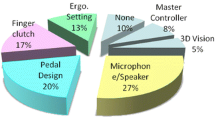Abstract
There is increasing interest in understanding the toll that operating takes on a surgeon’s body. The effect of robotic surgery on surgeon discomfort has not been studied. We sought to document the discomfort of robotic surgery compared with open and laparoscopic surgery and to investigate the factors that affect the risk of physical symptoms. Nineteen-thousand eight-hundred and sixty-eight surgeons from all specialties trained in the use of robots were sent a 26-question online survey and 1,407 responded. One-thousand two-hundred and fifteen surgeons who practiced all three approaches were used in the analysis. Eight-hundred and seventy-one surgeons had physical discomfort or symptoms attributable to operating. Of those with symptoms, 55.4% attributed most of the symptoms to laparoscopic surgery, 36.3% to open surgery, and 8.3% to robotic surgery. A higher case load was predictive of increased symptoms for open and laparoscopic surgery, but not for robotic surgery. Robotic surgery was less likely than open or laparoscopic surgery to lead to neck, back, hip, knee, ankle, foot, and shoulder pain and less likely than laparoscopic surgery to lead to elbow and wrist pain. Robotic surgery was more likely than either open or laparoscopic surgery to lead to eye pain, and more likely than open surgery to lead to finger pain. Nearly a third (30.3%) of surgeons admit to giving consideration to their own discomfort when choosing an operative modality. Robotic surgery has promise in reducing the risk of physical discomfort for the operator. This is important as more surgeons consider their own health when choosing a surgical modality.



Similar content being viewed by others
References
Park A, Lee G, Seagull FJ, Meenaghan N, Dexter D (2010) Patients benefit while surgeons suffer: an impending epidemic. J Am Coll Surg 210(3):306–313
Berguer R, Rab GT, Abu-Ghaida H, Alarcon A, Chung J (1997) A comparison of surgeons’ posture during laparoscopic and open surgical procedures. Surg Endosc 11(2):139–142
Nguyen NT, Ho HS, Smith WD et al (2001) An ergonomic evaluation of surgeons’ axial skeletal and upper extremity movements during laparoscopic and open surgery. Am J Surg 182(6):720–724
Gofrit ON, Mikahail AA, Zorn KC et al (2008) Surgeons’ perceptions and injuries during and after urologic laparoscopic surgery. Urology 71(3):404–407
Stomberg MW, Tronstad S-E, Hedberg K et al (2010) Work-related musculoskeletal disorders when performing laparoscopic surgery. Surg Laparosc Endosc Percutan Tech 20(1):49–53
Szeto GPY, Ho P, Ting ACW et al (2009) Work-related musculoskeletal symptoms in surgeons. J Occup Rehabil 19(2):175–184
van Det MJ, Meijerink WJHJ, Hoff C, van Veelen MA, Pierie JPEN (2008) Ergonomic assessment of neck posture in the minimally invasive surgery suite during laparoscopic cholecystectomy. Surg Endosc 22(11):2421–2427
Liberman AS, Shrier I, Gordon PH (2005) Injuries sustained by colorectal surgeons performing colonoscopy. Surg Endosc 19(12):1606–1609
van Det MJ, Meijerink WJHJ, Hoff C, Totté ER, Pierie JPEN (2009) Optimal ergonomics for laparoscopic surgery in minimally invasive surgery suites: a review and guidelines. Surg Endosc 23(6):1279–1285
van Veelan MA, Jakimowicz JJ, Kazemier G (2004) Improved physical ergonomics of laparoscopic surgery. Minim Invasive Ther Allied Technol 13(3):161–166
Wauben LSGL, van Veelen MA, Gossot D, Goossens RHM (2006) Application of ergonomic guidelines during minimally invasive surgery: a questionnaire survey of 284 surgeons. Surg Endosc 20(8):1268–1274
Youssef Y, Lee G, Godinez C et al (2011) Laparoscopic cholecystectomy poses physical injury risk to surgeons: analysis of hand technique and standing position. Surg Endosc. Available at: http://www.ncbi.nlm.nih.gov/pubmed/21432008. Accessed April 1 2011
Herron DM, Marohn M (2007) A Consensus Document on Robotic Surgery: Prepared by the SAGES-MIRA Robotic Surgery Consensus Group. Available at: http://www.sages.org/publication/id/ROBOT/. Accessed March 14 2011
Berguer R, Smith W (2006) An ergonomic comparison of robotic and laparoscopic technique: the influence of surgeon experience and task complexity. J Surg Res 134(1):87–92
van der Schatte Olivier RH, Van’t Hullenaar CDP, Ruurda JP, Broeders IAMJ (2009) Ergonomics, user comfort, and performance in standard and robot-assisted laparoscopic surgery. Surg Endosc 23(6):1365–1371
Bagrodia A, Raman JD (2009) Ergonomics considerations of radical prostatectomy: physician perspective of open, laparoscopic, and robot-assisted techniques. J Endourol 23(4):627–633
Elhage O, Murphy D, Challacombe B, Shortland A, Dasgupta P (2007) Ergonomics in minimally invasive surgery. Int J Clin Pract 61(2):186–188
Lee J, Kang SW, Jung JJ et al (2011) Multicenter study of robotic thyroidectomy: short-term postoperative outcomes and surgeon ergonomic considerations. Ann Surg Oncol. Available at: http://www.ncbi.nlm.nih.gov/pubmed/21373954. Accessed April 1 2011
Berguer R, Smith WD, Chung YH (2001) Performing laparoscopic surgery is significantly more stressful for the surgeon than open surgery. Surg Endosc 15(10):1204–1207
Sprague S, Quigley L, Bhandari M (2009) Survey design in orthopaedic surgery: getting surgeons to respond. J Bone Joint Surg Am 91(Suppl 3):27–34
Conflict of interest
Dr Wren does technical consulting and speaking for Intiutive Surgical, the maker of the Da Vinci Robotic Surgical System. Drs Plerhoples and Hernandez-Boussard have no conflicts of interest or financial ties to disclose.
Author information
Authors and Affiliations
Corresponding author
Rights and permissions
About this article
Cite this article
Plerhoples, T.A., Hernandez-Boussard, T. & Wren, S.M. The aching surgeon: a survey of physical discomfort and symptoms following open, laparoscopic, and robotic surgery. J Robotic Surg 6, 65–72 (2012). https://doi.org/10.1007/s11701-011-0330-3
Received:
Accepted:
Published:
Issue Date:
DOI: https://doi.org/10.1007/s11701-011-0330-3




